Still Suffering Around Annapurna

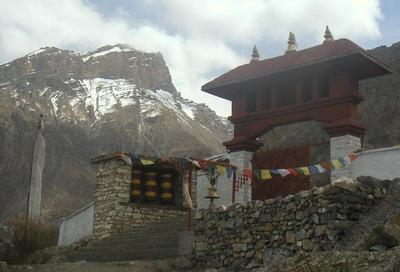
Note: This is the third episode of the Annapurna travelogue, which is in 4 parts.
The view from the top was great! But the trail down the other side was long and horrendous, until your legs just collapsed at the bottom after losing tremendous amounts of altitude (1600 meters – nearly a mile straight down – after having climbed 1000 meters on snow to the top that morning), in the religious pilgrimage town of Muktinath. There is a Buddhist shrine here where the sacred water/fire/stone come together in one place, with 108 waterspouts and more prayer flags, prayer whels, and fantastic images than you can believe; we bought and lit butter candles, and felt appropriately in awe. We came across some ladies selling
 bits and pieces from Tibet (or so they indicated) – things old, odd, and natural are revered so I now have a bit of animal horn and a chunk of what I hope is turquoise to remember them by. I took part of a day off and chased baby goats, we hit the road and blam, gone were the high snow covered peaks, mostly out of sight for the rest of the trip. We passed some little towns that were the real thing – major stops like Muktinath have the mark of tourism (often subtle – just a few little stores and guesthouses) while these were weathered collections of wattle and daub and stone that were in the process of crumbling; despite the rush to keep making progress (the manifest destiny of the Annapurna circuit– finish in 3 weeks) I drank a pot of mint tea in every one I could.
bits and pieces from Tibet (or so they indicated) – things old, odd, and natural are revered so I now have a bit of animal horn and a chunk of what I hope is turquoise to remember them by. I took part of a day off and chased baby goats, we hit the road and blam, gone were the high snow covered peaks, mostly out of sight for the rest of the trip. We passed some little towns that were the real thing – major stops like Muktinath have the mark of tourism (often subtle – just a few little stores and guesthouses) while these were weathered collections of wattle and daub and stone that were in the process of crumbling; despite the rush to keep making progress (the manifest destiny of the Annapurna circuit– finish in 3 weeks) I drank a pot of mint tea in every one I could.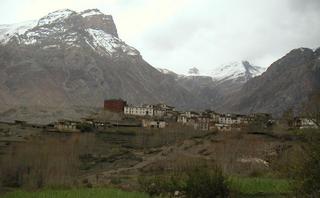
Across more dramatic rain shadow plains that reminded me of Idaho, we finally came to Kagbeni, a beautiful town (I should have stayed there!) that was a green oasis of wheat/millet and fruit trees right before the river of stones took off for Upper Mustang – the legendary place that most tourists are forbidden to enter for fear of changing the people (but enough $$ will get you there);
 I just looked and longed, glad someplace is set a little bit aside for the people and the future. Kagbeni was a delightfully cramped place with narrow streets, interesting food, friendly people, and animals everywhere (always important). There is a famous statue here which I am sure gets its share of photo ops – the embarrassing member was removed for safe keeping the day I was there.
I just looked and longed, glad someplace is set a little bit aside for the people and the future. Kagbeni was a delightfully cramped place with narrow streets, interesting food, friendly people, and animals everywhere (always important). There is a famous statue here which I am sure gets its share of photo ops – the embarrassing member was removed for safe keeping the day I was there. The road out towards Jompson and Tatopani was hard and long, on a stony river bed in the rain. I’m afraid that rain does little to enhance the experience for me, especially when your gut is tearing itself up. My memories of this section are the least, as I kept my head down and an eye out for toilet spots. The huge riverbed is almost a highway, with animals being driven down the middle, nomadic
The road out towards Jompson and Tatopani was hard and long, on a stony river bed in the rain. I’m afraid that rain does little to enhance the experience for me, especially when your gut is tearing itself up. My memories of this section are the least, as I kept my head down and an eye out for toilet spots. The huge riverbed is almost a highway, with animals being driven down the middle, nomadic  teahouses made out of river flotsam, and even an occasional tractor (Something motorized! They were flown in and just ply the stretch to Jompson.).
teahouses made out of river flotsam, and even an occasional tractor (Something motorized! They were flown in and just ply the stretch to Jompson.).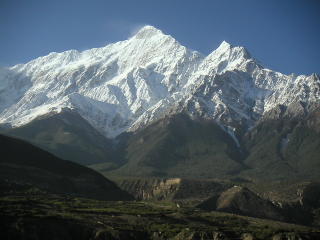
We stumbled into Jompson, home of the only other airport on the circuit and a significant tourism hub – all our Israelis (and other nationalities) friends were holed up here, eating better food and playing cards. I found a pharmacy-like thing and bought more medicine for the bronchitis that had been with me for months, and quickly left this scrap of civilization without regret. Rich flew out here suffering from schedule (he went on to see Chitwan too) and foot problems, so it was just taciturn Raj (now with something strange growing bigger by
 the day under the skin on one leg – anxious for home) and me, mile after mile. At some point it really does start to seem like you are leaving, your experience is coming to an end, and your time is up.
the day under the skin on one leg – anxious for home) and me, mile after mile. At some point it really does start to seem like you are leaving, your experience is coming to an end, and your time is up.  As with most of the trip you are traveling deep in a gorge with monsters like Dhaulagiri (at 8167 m, the seventh tallest mountain in the world – the full moon made it spectacular),and Annapurna on either side; technically the Kali Gandaki River gorge is the deepest in the world (6000 m or 20,000 ft!) but you don’t feel the whole depth looming over you. Just as impressive is having well shaped Nilgiri (~7000 m) tower over your back as you pull into Tatopani. The name means “hot water” and indeed it had hot springs and it was a chance to get clean for a change. A leg of chicken was the first meat in weeks, there was even chocolate cake, and it was a good excuse for an extra day of rest – we had failed to find the carrot brandy in Marpha, and still couldn’t seem to slow down as much as I wanted – something resembling Manifest Destiny forced us toward the trail’s end.
As with most of the trip you are traveling deep in a gorge with monsters like Dhaulagiri (at 8167 m, the seventh tallest mountain in the world – the full moon made it spectacular),and Annapurna on either side; technically the Kali Gandaki River gorge is the deepest in the world (6000 m or 20,000 ft!) but you don’t feel the whole depth looming over you. Just as impressive is having well shaped Nilgiri (~7000 m) tower over your back as you pull into Tatopani. The name means “hot water” and indeed it had hot springs and it was a chance to get clean for a change. A leg of chicken was the first meat in weeks, there was even chocolate cake, and it was a good excuse for an extra day of rest – we had failed to find the carrot brandy in Marpha, and still couldn’t seem to slow down as much as I wanted – something resembling Manifest Destiny forced us toward the trail’s end.At some point in every trip you are no longer headed “out”, you are on your way
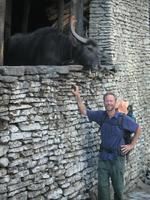 “back”) now took us straight up through a distant area where few foreigners were seen – it was the end of the season so none were still on the trail. Instead we saw villagers turning boulders into gravel with hammers (surely the most menial job I have seen), houses under construction with the crudest tools, beautiful stones stairs, and rhododendron forests dripping with moss. We had every town to ourselves at night and I always took the opportunity to pretend that I was the first Westerner to arrive there – in Nepal you know that this is never the case, but it might as well be, since no one is going to start up a conversation with you (little English is spoken, or needed, here); I must have explorer genes, causing me to search for
“back”) now took us straight up through a distant area where few foreigners were seen – it was the end of the season so none were still on the trail. Instead we saw villagers turning boulders into gravel with hammers (surely the most menial job I have seen), houses under construction with the crudest tools, beautiful stones stairs, and rhododendron forests dripping with moss. We had every town to ourselves at night and I always took the opportunity to pretend that I was the first Westerner to arrive there – in Nepal you know that this is never the case, but it might as well be, since no one is going to start up a conversation with you (little English is spoken, or needed, here); I must have explorer genes, causing me to search for  new places and tell stories. The way was mostly uneventful except for the thousands of painful stone steps both up and down, and some of my most local experiences of the trek – chased down the narrow street by a water buffalo family, downloading all my medicines to old people wracked by coughs and trampled by livestock, and privy to a very private and spooky late night animistic ceremony (I
new places and tell stories. The way was mostly uneventful except for the thousands of painful stone steps both up and down, and some of my most local experiences of the trek – chased down the narrow street by a water buffalo family, downloading all my medicines to old people wracked by coughs and trampled by livestock, and privy to a very private and spooky late night animistic ceremony (I 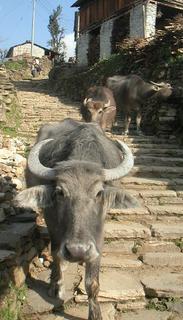 never understood a word or a gesture, just cowered in the dark while the shamans performed – don’t even think about taking a photo).
never understood a word or a gesture, just cowered in the dark while the shamans performed – don’t even think about taking a photo).Poon Hill, at the top, is the destination of many visitors because it offers an unparralled view of a huge number of mountains. The town is perched on a ridge and is way too modern (able to accommodate many tourists during the busy season) and we the promised mountain view after a near ritualistic ascent to see them right at dawn (I paid off the Maoists at a discount, as a Canadian – the government has been kicked out of this area) – the mountains are many but the distance great, while I like mine right on top of me.

Photo: The view from Poon Hill (3210 meters - nearly 2 miles high!) at sunrise, with Dhaulagiri (8167 m) dominating the skyline.
 The kids and the animals were exceptional, having none of the bad habits that I had been warned of (soliciting change/candy/pens) and they were happy to pause for photos – what must I seem like to them, a solitary traveler from some unknown nation? How had people like me changed their lives – brought cash to their economy, provided a little electricity, a continuous reminder that there was more out there than other tiny villages tucked into the hills? I would have given my left
The kids and the animals were exceptional, having none of the bad habits that I had been warned of (soliciting change/candy/pens) and they were happy to pause for photos – what must I seem like to them, a solitary traveler from some unknown nation? How had people like me changed their lives – brought cash to their economy, provided a little electricity, a continuous reminder that there was more out there than other tiny villages tucked into the hills? I would have given my left  leg to stay a few days (meanwhile, the thing growing inside Raj’s leg was bigger than a duck egg by now so there was no stopping), but what would I have done? Mostly because of the language barrier Nepal seems to be a place that you only
leg to stay a few days (meanwhile, the thing growing inside Raj’s leg was bigger than a duck egg by now so there was no stopping), but what would I have done? Mostly because of the language barrier Nepal seems to be a place that you only  pass through and sample briefly – any attempt to extract more from it by lingering (read a book by the side of the trail?) might spoil the experience by emphasizing how much of an outsider you really are. Trekking is a perfect way to see the country – you are constantly moving, tired, hungry, amazed, distracted, etc. as you get to look right into their homes, but there is little chance you’ll interfere or be lonely.
pass through and sample briefly – any attempt to extract more from it by lingering (read a book by the side of the trail?) might spoil the experience by emphasizing how much of an outsider you really are. Trekking is a perfect way to see the country – you are constantly moving, tired, hungry, amazed, distracted, etc. as you get to look right into their homes, but there is little chance you’ll interfere or be lonely.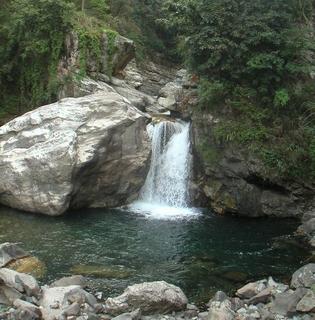 Going downhill was a relief after so many days of climbing, but the end of the road meant a return to the spectacles of civilization – the last town (Phedi) turned out to be a booming construction town, teeming with workers dynamiting the rock and resolute upon paving the entire Circuit in the next 100 years; progress is a frightening thing, but at least it will take time. It was a crazy mix of images and experiences – I was in the lowlands again, lush and fertile and well populated. The waterfalls and river are beautiful and meant another chance to wash up before facing the world. But the world was garish and unworthy, filled wit ice cream vendors, trash, needy people, and urban squalor. We banded together to hire a car to take us to Pokhara (second largest town) where I immediately got a shave (with a straight razor in an outdoor shop, of course), rented a bike, ate all kinds of food, weathered out another Maoist bandha (regional strike, shutting everything down – particularly transportation), and finally caught a bus back to Kathmandu; how come I couldn’t bring myself to photograph the burned out bus carcass in the middle of the road, or the insane mountain road conditions? Probably because the bus was too crowded, or I was avoiding looking too much like a tourist.
Going downhill was a relief after so many days of climbing, but the end of the road meant a return to the spectacles of civilization – the last town (Phedi) turned out to be a booming construction town, teeming with workers dynamiting the rock and resolute upon paving the entire Circuit in the next 100 years; progress is a frightening thing, but at least it will take time. It was a crazy mix of images and experiences – I was in the lowlands again, lush and fertile and well populated. The waterfalls and river are beautiful and meant another chance to wash up before facing the world. But the world was garish and unworthy, filled wit ice cream vendors, trash, needy people, and urban squalor. We banded together to hire a car to take us to Pokhara (second largest town) where I immediately got a shave (with a straight razor in an outdoor shop, of course), rented a bike, ate all kinds of food, weathered out another Maoist bandha (regional strike, shutting everything down – particularly transportation), and finally caught a bus back to Kathmandu; how come I couldn’t bring myself to photograph the burned out bus carcass in the middle of the road, or the insane mountain road conditions? Probably because the bus was too crowded, or I was avoiding looking too much like a tourist.
I celebrated Kathmandu again, reacquainting myself with all the street children again by taking them out for meals and teaching them guerrilla marketing techniques so they could sell cheap trinkets (made in China) to tourists more effectively. The streets of Thamel are dense with things to do and I tried to do them all (food, email, etc.), but for some reason I felt that I had not spent enough time high in
the mountains – I had briefly peaked out incredibly high at Thorung La, but had only been in the land of yaks for a day or so (they can only thrive above 10,000 ft). And another bandh was upon me – there was rioting in the streets, it was dangerous to go certain places, sacred cows mingles with burned out vehicles in the empty
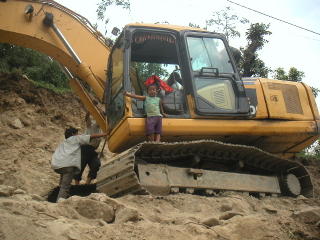 streets – it was time to leave town. I was almost too late – the economy shuts down ahead of time it turns out, as bus drivers, etc. go home to their villages while they can; I missed by chance to trek in the Langtang region (no buses!) and just barely caught a scary flight into the Everest region (the one after me and killed all aboard), after spending 3 days in the primitive airport; I have now learned patience.
streets – it was time to leave town. I was almost too late – the economy shuts down ahead of time it turns out, as bus drivers, etc. go home to their villages while they can; I missed by chance to trek in the Langtang region (no buses!) and just barely caught a scary flight into the Everest region (the one after me and killed all aboard), after spending 3 days in the primitive airport; I have now learned patience.
Photo: Even the youngest child knows the Sanskrit "namaste", literally "I bow before you" but actually more like "the spirit in me meets the same spirit in you". A beautiful greeting!
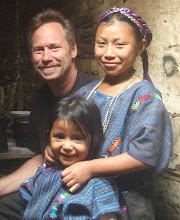

0 Comments:
Post a Comment
<< Home